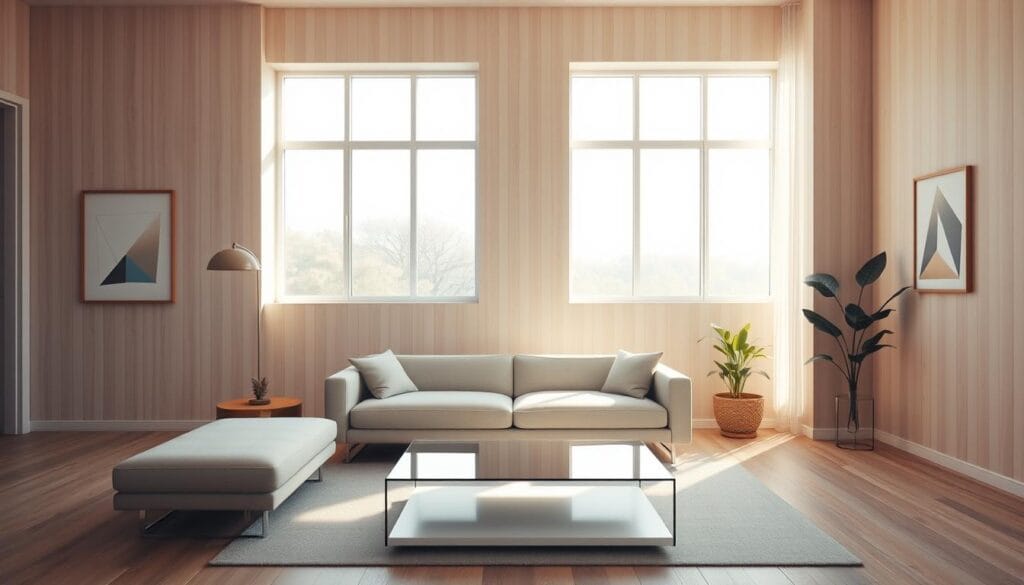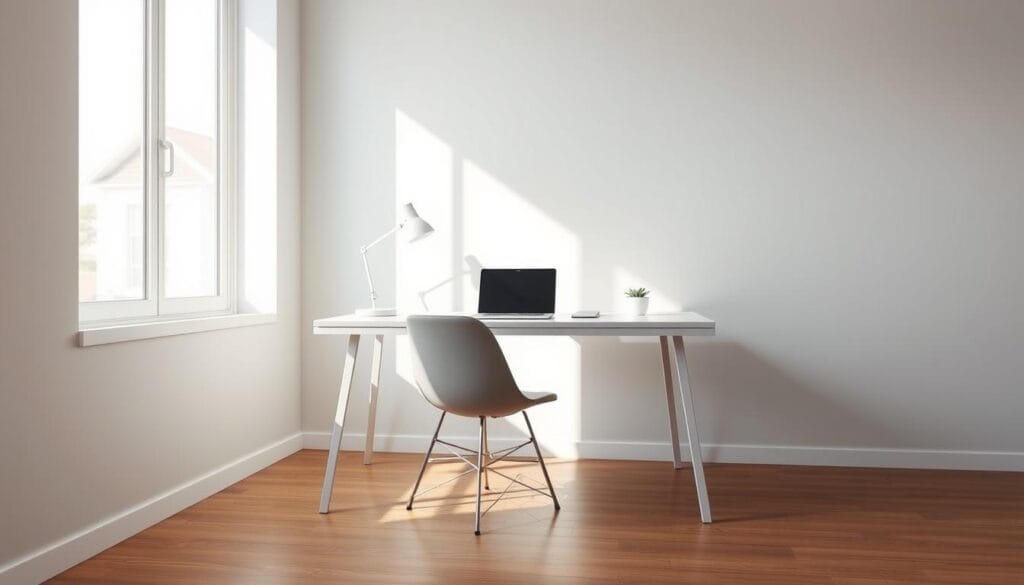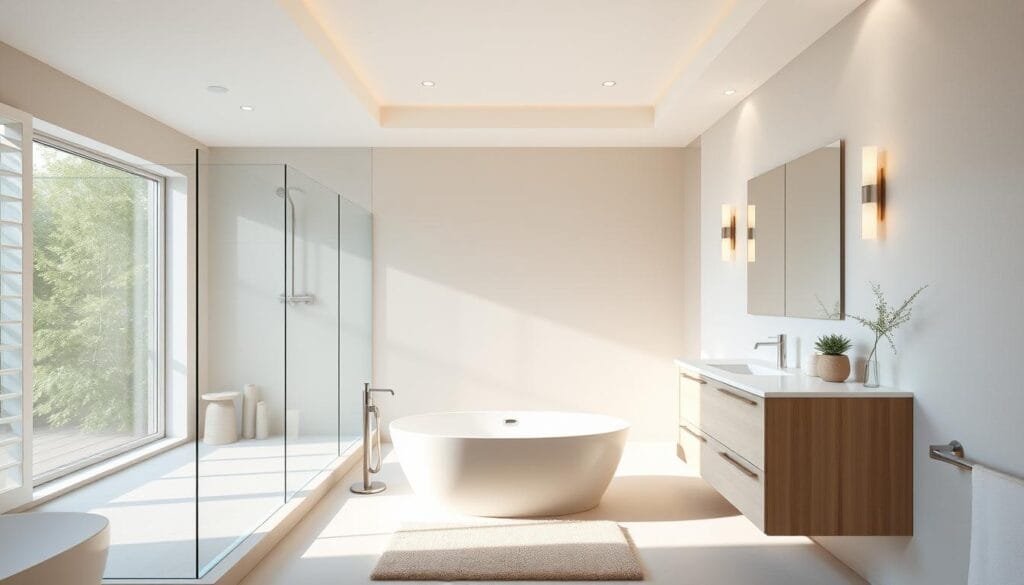Imagine entering a room where everything has a place, free of clutter. The air seems lighter, and you feel peace right away. This dream can become your reality with minimalist room design. In today’s busy life, finding calmness and focus is very important. Reducing your stuff by about 70% can make your space feel open and serene. Minimalist design can make your home look better and improve how you feel.
A friend inspired me with their home office makeover. They chose sleek designs over bulky furniture, and guess what? Their work output jumped by almost 40%! Isn’t that amazing?! We have gathered lots of tips and essentials for your minimalist room. Whether you’re learning the basics or picking colors, we’re here to help you every step of the way. 🌱
We’re diving into minimalist room design, where less is definitely more. You’ll learn to create a space that’s both stylish and functional, a true sanctuary. We’ll cover how to declutter, the best lighting, and more. Ready for this calming journey? Let’s get started! 🌟
Understanding Minimalist Room Design
Minimalist room design focuses on simplicity, starting from the 1960s and 1970s. It became popular after World War II, with Ludwig Mies van der Rohe’s “less is more” belief. It’s about living with just what you need, using straightforward decor and simple colors. This style became even more liked in the 1980s and still affects today’s interior design.
What is Minimalism in Interior Design?
Minimalism in interior design means using few elements for a big effect. It values function, clean shapes, and keeping things basic. You’ll see neutral colors, uncomplicated designs, and natural light. The goal is to avoid clutter. This helps clear the mind and improves well-being.
Key Principles of Minimalism
Several key principles define minimalist design:
- Simplicity: Focus on clean decor and cut out what’s not needed.
- Functionality: Everything should have a use, showing that less truly is more.
- Neutral Colors: Use simple color schemes like whites, beiges, and grays.
- Open Spaces: Aim for open, tidy floor plans for a calm setting.
- Natural Light: Let in natural light to make spaces bright and big.
- Timeless Décor: Pick classic pieces that stay in style and don’t need frequent changes.
Benefits of Minimalist Designs
Choosing minimalist design has lots of pluses. It makes you organize, cutting down stress. Minimalist homes are more peaceful and welcoming. With less clutter, your mind feels clearer and upkeep is simpler. This style also leans towards green living. It encourages buying less but better quality. This choice can save money over time, making it not only good for us but the planet too.
Choosing the Right Color Palette
Picking the perfect color palette is key to creating a space that feels modern and minimalist. The right colors not only make the room look better but also set the mood. Here are some tips on how to choose simple room colors.
Popular Minimalist Color Schemes
Choosing a minimalist look means using about three to five colors. This keeps the look unified and balanced. Whites, grays, and beiges are popular because they make a space feel clean and calm. Tools like Coolors or the Pantone app can help pick colors from photos to inspire your minimalistic design.

Importance of Neutral Tones
Neutral tones are very important for minimalist designs. Whites, grays, and beiges are like a blank canvas. They go well with many decorating styles and make a room feel 20% more livable. These colors can also make a small space seem 20% bigger and are great for highlighting other decor without making the room feel too busy. Neutral light colors help reflect natural light, making spaces seem 10-30% larger.
Accent Colors for Minimalist Rooms
In a minimalist room, adding a few bold colors can make a big difference. Colors like dark blue, bright yellow, or deep green can catch the eye and add interest. Just a little bit of these colors can change a boring room into something exciting without being too much. The right splash of color can make people 25% happier with the room, turning a simple space into something special.
Selecting Furniture for Minimalist Spaces
In making a minimalist room, choosing the right furniture is key. You need things like a well-sized bed, sleek sofas, and smart storage. Each piece must have a clear use and keep the room looking tidy and together.
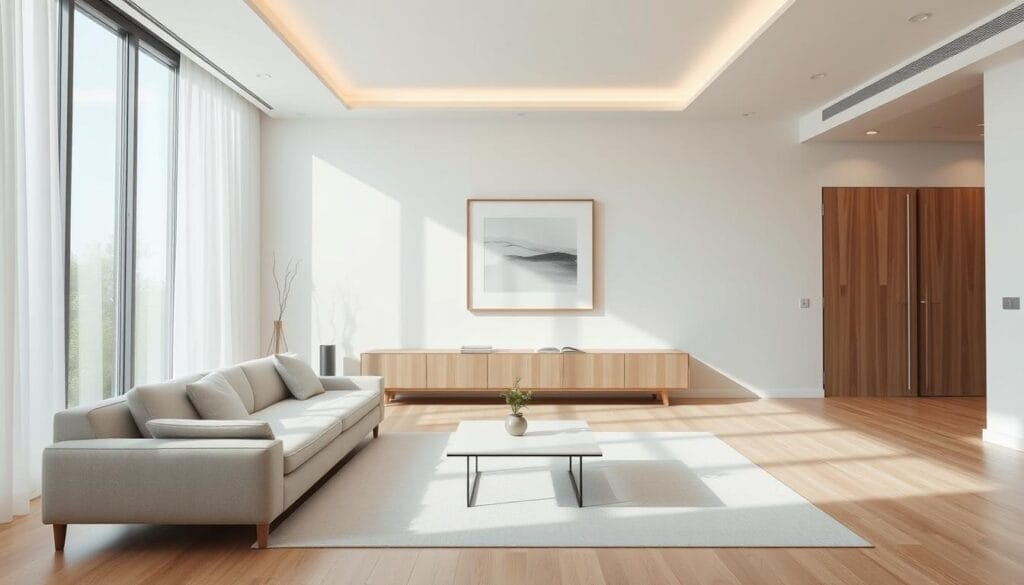
Essential Furniture Pieces
It’s vital to pick key furniture for a minimalist home to look right. A calming room with simple colors helps with relaxation. A good bed from brands like ARTLESS or Ferm Living adds comfort and style. You can also use smart furniture, like storage ottomans, to save space and stay chic.
Functional vs. Aesthetic
Finding a balance between use and beauty is crucial in minimalist design. Opting for a few high-quality items is better than lots of cheap ones. Brands like Greenington offer furniture that’s both useful and stylish. For instance, an elegant quilt from Ann Gish can add beauty and function to a bedroom.
Natural light also plays a huge role in minimalist design, adding a sense of peace. Research shows that using white space makes a room feel cleaner and more open. Adding plants can also purify the air and bring calm, which is perfect for minimalist styling.
If you want more tips on minimalist furniture, check out more insights here. Stylish storage solutions are also key to keep things neat and true to minimalist ideals.
Decluttering for a Minimalist Look
To get a minimalist look, start by decluttering. This creates clean decor lines and a simple design. It makes room for minimalist ideas in your space. Sort and organize your things to keep the place tidy.
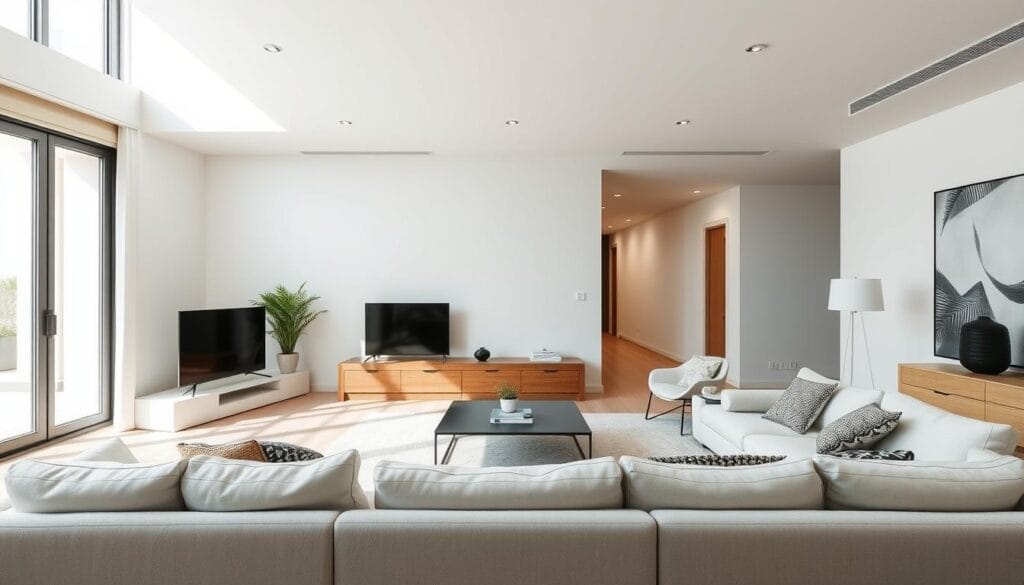
Steps to Declutter Your Space
Begin with just one area to keep things manageable. Then, sort items into 4 boxes: Donate/Sell, Garbage, Recycling, and Keep. This method helps a lot.
- First, pick items you truly need.
- Get rid of extras to minimize clutter.
- For things you’re unsure about, use a “penalty box”. Check them after 1, 3, or 6 months.
- Make sure every item has its place.
- If it’s valuable, sell it for about 20% of its original price.
Following these steps makes decluttering easier. It also helps you keep your space neat in the long run.
Maintaining a Clutter-Free Environment
After decluttering, keep your space simple. Regular checks help make sure everything has a purpose. This maintains the minimalist design. Here’s how:
- Take 15 minutes daily to tidy up areas like countertops.
- Use the one-in-one-out rule to avoid clutter.
- Clean places like the kitchen often, removing unneeded items.
- Smart storage increases space and organization by 25%.
Keeping your place tidy not only looks good but also reduces stress by up to 20%. Limit decor items to 5-7 pieces for a better look and feel. Decluttering often means less cleaning, making your home more enjoyable.
Flooring Options for Minimalist Design
The flooring choice is key in a minimalist room design. It needs to show clean lines and simplicity. In this guide, you’ll see the top flooring picks and how rugs can add to the minimalism in your home.
Best Flooring Choices
Hardwood floors are top picks for a minimalist look. Their timeless look fits right in with simple decor. Also, luxury vinyl planks and tiles are great because they look like natural materials but are easy to care for and water-resistant.
Bamboo flooring is eco-friendly and makes up 15% of the sustainable flooring market. Polished concrete floors have become 30% more popular in modern designs. Big ceramic tiles also make a room look bigger by up to 20%.
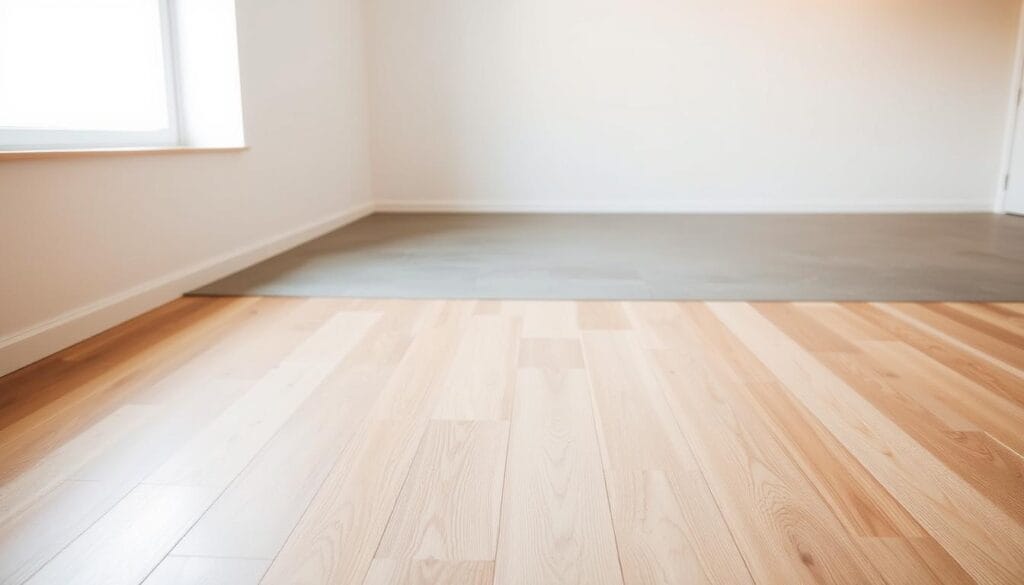
| Flooring Type | Attributes |
|---|---|
| Hardwood | Timeless, Light or Dark Tones, Natural Look |
| Luxury Vinyl Planks | Affordable, Easy to Maintain, Mimics Natural Materials |
| Polished Concrete | Modern, Increases Room Size, Durable |
| Bamboo | Eco-Friendly, Sustainable, Unique Texture |
| Large Ceramic Tiles | Minimal Grout Lines, Spacious Feel, Clean Lines |
How to Incorporate Rugs
Adding rugs to a minimalist design needs care. Choose rugs with simple patterns and neutral colors. Textured rugs like wool or cotton can add interest without being too much. Rugs should help define spaces without making them feel cluttered.
Use rugs to set apart areas in an open space. A neutral rug under the coffee table can make a cozy living area. It keeps the design clean and simple.
With these flooring choices and smart rug use, we can create a minimalist space. It’s where simplicity and elegance meet. This creates rooms that are not only stunning but also practical.
Lighting in Minimalist Room Design
Effective lighting is key in minimalist design. Choosing the right lights and using natural light make a space feel open and airy. This is crucial for that sleek look in interior decor. We’ll look at lighting types and how best to use natural light for minimalist style.
Types of Lighting Fixtures
In minimalist rooms, the lighting is very important for the clean look. Think about using recessed lighting or simple pendant lights. These have clean designs and are practical, fitting well with minimalist style. Also, using LED bulbs saves energy and works well, matching the minimalist approach.
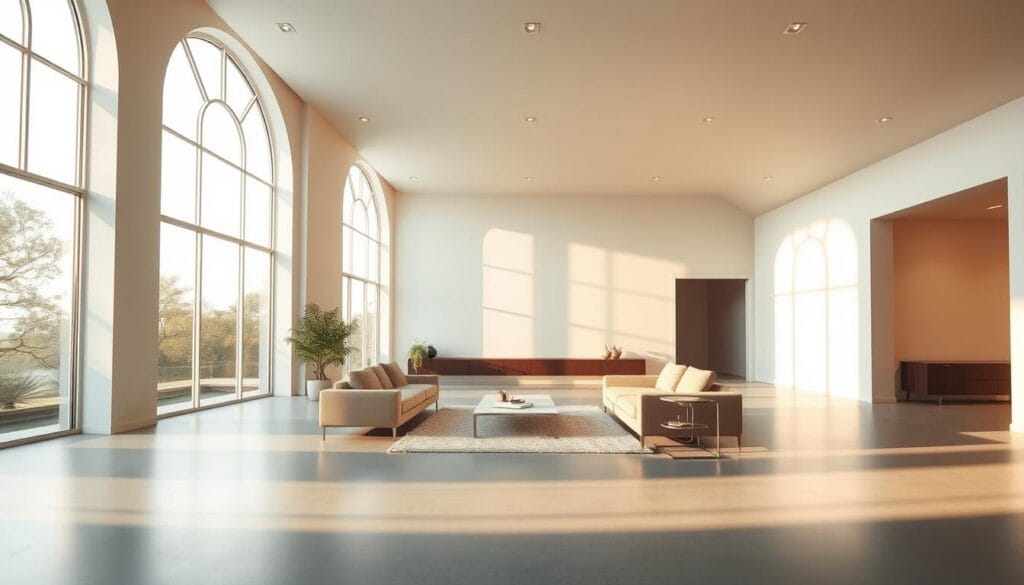
Choosing the right materials for light fixtures matters. Metals and glass keep things sleek. High-quality lights, like frosted globe lights chosen by designer Victoria Ninette, don’t just look good. They also perform well, making your minimalist space better in the long run.
Natural Light Considerations
Maximizing natural light is vital for sleek decor. Big windows, open layouts, and sheer curtains let in lots of sunlight. But when there’s not enough natural light, you need good artificial lights. Minimalist design often relies on layered lighting. This might include ceiling lights, wall lamps, and floor lamps for a flexible and useful lighting setup. A cool tip is using floor-to-ceiling drapes. They add to the room’s openness and coziness.
Getting the balance right between natural and artificial light keeps your space bright and welcoming. Adding these sleek lighting ideas to your minimalist design creates a calm, functional, and beautiful area.
Accessorizing a Minimalist Room
Accessorizing a minimalist room focuses on balance and meaning. Accessories should enhance the room by adding personal touches, yet not overload it. They must maintain the clean, calm vibe that is key to modern minimalism.
Minimalist Decor Ideas
Essential minimalist decor includes single, large art pieces. Oversized paintings or photos make for a bold central point without crowding walls. Functional decor, like stylish clocks, sculptural vases, or lamps, adds both beauty and utility.
Add natural textures to bring warmth and interest. Think wooden items, leather cushions, or jute rugs. In minimalist living rooms, these textures add depth without creating clutter.
Tips for Selecting Accessories
Choosing the right accessories needs a thoughtful approach. Favor quality over quantity, embracing the ‘less is more’ idea. Stick to neutral colors like white, cream, gray, and brown to match your decor.
Mirrors are great for minimalist spaces. They make rooms feel bigger and brighter, and add elegance. Put large mirrors in places where they can catch light, making spaces feel more open.
Every accessory should serve a purpose, either functional or for looks. Items like storage ottomans offer extra utility without clutter. Plants are excellent accessories, adding life and softening minimalist designs.
Using these tips to design a minimalist room ensures a beautiful, functional, serene space. It reflects the true spirit of modern minimalism.
Creating a Functional Layout
A functional layout is key to modern minimalism. It’s all about using space wisely to be both useful and look good. Let’s explore how to do this.
Space Planning Principles
Putting furniture and decorations in the right spot is crucial. Did you know 70% of people say it makes a room work better? Begin with the big items, as most designers suggest. This sets up the basic layout for the room.
Opt for simple, clean decor to keep things looking neat. Remember, choosing a few quality items is better than lots of cheaper ones. This approach not only looks better but also makes each item meaningful.
Flow and Accessibility
Good flow and easy access are key for a great layout. Surprisingly, half of the homeowners don’t think about this, and it causes problems. Creating distinct areas, especially in open spaces, helps 80% of people. It keeps things organized and functional.
Keeping clear views across the room improves flow and looks. Around 65% of folks appreciate this because it makes spaces enjoyable. Also, it’s important to have enough empty space. Almost everyone who gets layout right uses this trick to prevent a cluttered feel.
A minimalist space should be well-organized – everything should have its spot. This idea is essential not just for looks but for keeping the space easy to use. The right mix of looks and function can make your home feel inviting and in harmony.
Incorporating Nature into Minimalism
Mixing biophilic design with minimalism isn’t just for looks. It greatly aids well-being. This method introduces nature’s elements into your space, offering big wellness benefits. It can purify the air and lessen stress, making your home healthier and happier.
Benefits of Biophilic Design
Biophilic design isn’t just popular; it’s backed by science for boosting wellness. Adding nature helps lower stress and anxiety. This brings more peace and confidence. With minimalism, it leads to a tidy space that betters sleep and health habits. A decluttered area paves the way for self-care.
Luis Barragán, an architect, highlighted the calmness in design that biophilic design can capture. Bringing nature into your minimalist space can improve your mental and emotional health.
Ways to Add Plants
Adding plants means more than just placing a pot. It’s about finding greenery that fits your simple style. Begin with easy plants like succulents or fiddle leaf figs, which match a minimalist look. Picking the right containers helps keep the style unified.
Enhance plant growth with natural light from big windows or skylights. Using vertical gardens or hanging plants saves space and adds a special feel, connecting you further to nature.
It’s not only the plants but also their surroundings. Use natural stone or pottery for a more organic feel. Go for bamboo or recycled wood furniture for sustainability. Combining these elements thoughtfully creates a balanced, nature-inspired area.
Personalizing Your Minimalist Space
Designing a minimalist yet personalized room means finding a balance. It’s about keeping things simple while adding your unique style. Adding personal touches to a sleek design makes your space feel like home. This doesn’t have to clash with minimalist modern principles.
Balancing Personal Touches and Minimalism
A minimalist design focuses on simplicity and cutting down on clutter. This can make a room feel 30% more spacious and calm. But, adding personal items can make it 40% more comfortable. The trick is to pick meaningful items carefully, without overwhelming the space. Try to use fewer than 10 decor pieces to keep the minimalist vibe yet add personality. A special throw or a family heirloom can bring warmth and a personal feel, boosting your connection to the room by 35%.
Neutral colors work well in minimalist spaces, preferred by 65% of people. Colors like white, gray, and beige create calm and let your personal items shine. Adding different textures and colors smartly can make the room 25% more interesting. This keeps things minimalist but adds character. For example, pairing a sleek metal lamp with a wooden table can add appeal.
Art and Minimalism
Art can deeply personalize a minimalist space. Choose art that means something to you and fits the minimalist style. This adds a powerful touch without crowding the room. A single, large painting works better than many small ones. It keeps the minimalist look while adding a strong visual.
Hang art at eye level or over a key furniture piece, like a sofa. This creates a focus point that ties the room together. Experts say that minimalist spaces with chosen art are seen as 70% more stylish. The aim is to complement your minimalist decor, maintaining openness and calm.
Mixing personal items with minimalist design lets you build a modern yet inviting space. Focus on meaningful items but keep it clutter-free. This thoughtful mixing makes your minimalist space appealing and personal. It shows who you are while keeping a stylish, serene look.
Maintaining a Minimalist Room
Keeping a minimalist room requires effort, but it’s worth it. A few strategies make this style easy to maintain. You can keep your space looking great with regular clean-ups and smart design choices. This way, you’ll enjoy a home that’s both peaceful and stylish.
Regular Upkeep Strategies
Regular decluttering is key for a minimalist room. Use the “one in, one out” rule to avoid collecting too much stuff. Storing items under the bed is also smart. It makes use of hidden space and keeps things neat.
Evaluating Your Design Choices
It’s important to check your room’s setup regularly. Ask if each item is both useful and nice to look at. Minimalism loves things simple and practical. So, make sure everything fits that idea. If something’s not useful anymore, you might want to get rid of it.
Keeping your space free of clutter is good for your mind. It lowers stress and makes you feel relaxed. For more tips on a minimalist home, check out these creative ideas.

